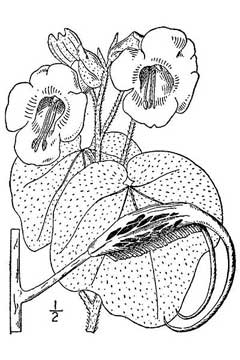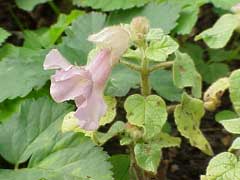 |
|
USDA-NRCS PLANTS Database |
 |
| biolib.de |
Translate this page:
Summary
Physical Characteristics

 Proboscidea louisianica is a ANNUAL growing to 1 m (3ft 3in).
Proboscidea louisianica is a ANNUAL growing to 1 m (3ft 3in).
See above for USDA hardiness. It is hardy to UK zone 10 and is frost tender. It is in flower from July to September. The species is hermaphrodite (has both male and female organs).
Suitable for: light (sandy), medium (loamy) and heavy (clay) soils and prefers well-drained soil. Suitable pH: mildly acid, neutral and basic (mildly alkaline) soils. It cannot grow in the shade. It prefers moist soil.
UK Hardiness Map
US Hardiness Map
Synonyms
P. louisiana. Martynia louisiana.
Plant Habitats
Cultivated Beds;
Edible Uses
Edible Parts: Fruit Oil Root Seed
Edible Uses: Oil
Young fruits, harvested whilst still tender enough to be pierced with a fork, can be sliced and added to soups as a thickening agent[85, 183]. They can also be parboiled and eaten as a vegetable or pickled in vinegar[183]. They are sometimes pickled when immature[1, 27, 61]. The fruit is about 4 - 6mm long[200]. Seed - raw or cooked. High in protein[183] and in oil[207]. An edible oil is obtained from the seed[183]. Root[2]. No more details are given.
References More on Edible Uses
Medicinal Uses
Plants For A Future can not take any responsibility for any adverse effects from the use of plants. Always seek advice from a professional before using a plant medicinally.
None known
References More on Medicinal Uses
The Bookshop: Edible Plant Books
Our Latest books on Perennial Plants For Food Forests and Permaculture Gardens in paperback or digital formats.

Edible Tropical Plants
Food Forest Plants for Hotter Conditions: 250+ Plants For Tropical Food Forests & Permaculture Gardens.
More

Edible Temperate Plants
Plants for Your Food Forest: 500 Plants for Temperate Food Forests & Permaculture Gardens.
More

More Books
PFAF have eight books available in paperback and digital formats. Browse the shop for more information.
Shop Now
Other Uses
Basketry Dye Oil
A black dye can be obtained from the seedpods[257]. The long pointed seed capsule horns can be used as the black pattern material in coiled basketry[257].
Special Uses
Scented Plants
References More on Other Uses
Cultivation details
Requires a well-drained porous soil in a warm sheltered position[200]. A frost-tender species, it can be grown outdoors in Britain as a half-hardy annual. This species is closely related to P. fragrans[200]. This species has occasionally been cultivated as a food crop[207, 274].
References Carbon Farming Information and Carbon Sequestration Information
Temperature Converter
Type a value in the Celsius field to convert the value to Fahrenheit:
Fahrenheit:
The PFAF Bookshop
Plants For A Future have a number of books available in paperback and digital form. Book titles include Edible Plants, Edible Perennials, Edible Trees,Edible Shrubs, Woodland Gardening, and Temperate Food Forest Plants. Our new book is Food Forest Plants For Hotter Conditions (Tropical and Sub-Tropical).
Shop Now
Plant Propagation
Seed - sow spring in a warm greenhouse. When they are large enough to handle, prick the seedlings out into individual pots and plant them out after the last expected frosts[200].
Other Names
If available other names are mentioned here
Native Range
NORTHERN AMERICA: United States (Kansas, Nebraska, Oklahoma, Colorado, New Mexico, Texas), Mexico (Chihuahua, Coahuila de Zaragoza, Durango, Nuevo León, San Luis Potosí, Sonora, Tamaulipas, Zacatecas, Baja California (Norte), Aguascalientes, Colima, Guanajuato, Guerrero, Hidalgo, Jalisco, México, Michoacán de Ocampo, Morelos, Nayarit, Oaxaca, Puebla, Querétaro, Quintana Roo, Tlaxcala, Veracruz de Ignacio de la Llave, Ciudad de México)
Weed Potential
Right plant wrong place. We are currently updating this section.
Please note that a plant may be invasive in one area but may not in your area so it's worth checking.
Conservation Status
IUCN Red List of Threatened Plants Status :

Growth: S = slow M = medium F = fast. Soil: L = light (sandy) M = medium H = heavy (clay). pH: A = acid N = neutral B = basic (alkaline). Shade: F = full shade S = semi-shade N = no shade. Moisture: D = dry M = Moist We = wet Wa = water.
Now available:
Food Forest Plants for Mediterranean Conditions
350+ Perennial Plants For Mediterranean and Drier Food Forests and Permaculture Gardens.
[Paperback and eBook]
This is the third in Plants For A Future's series of plant guides for food forests tailored to
specific climate zones. Following volumes on temperate and tropical ecosystems, this book focuses
on species suited to Mediterranean conditions—regions with hot, dry summers and cool, wet winters,
often facing the added challenge of climate change.
Read More
Expert comment
Author
(Mill.)Thell.
Botanical References
43200235
Links / References
For a list of references used on this page please go here
Readers comment